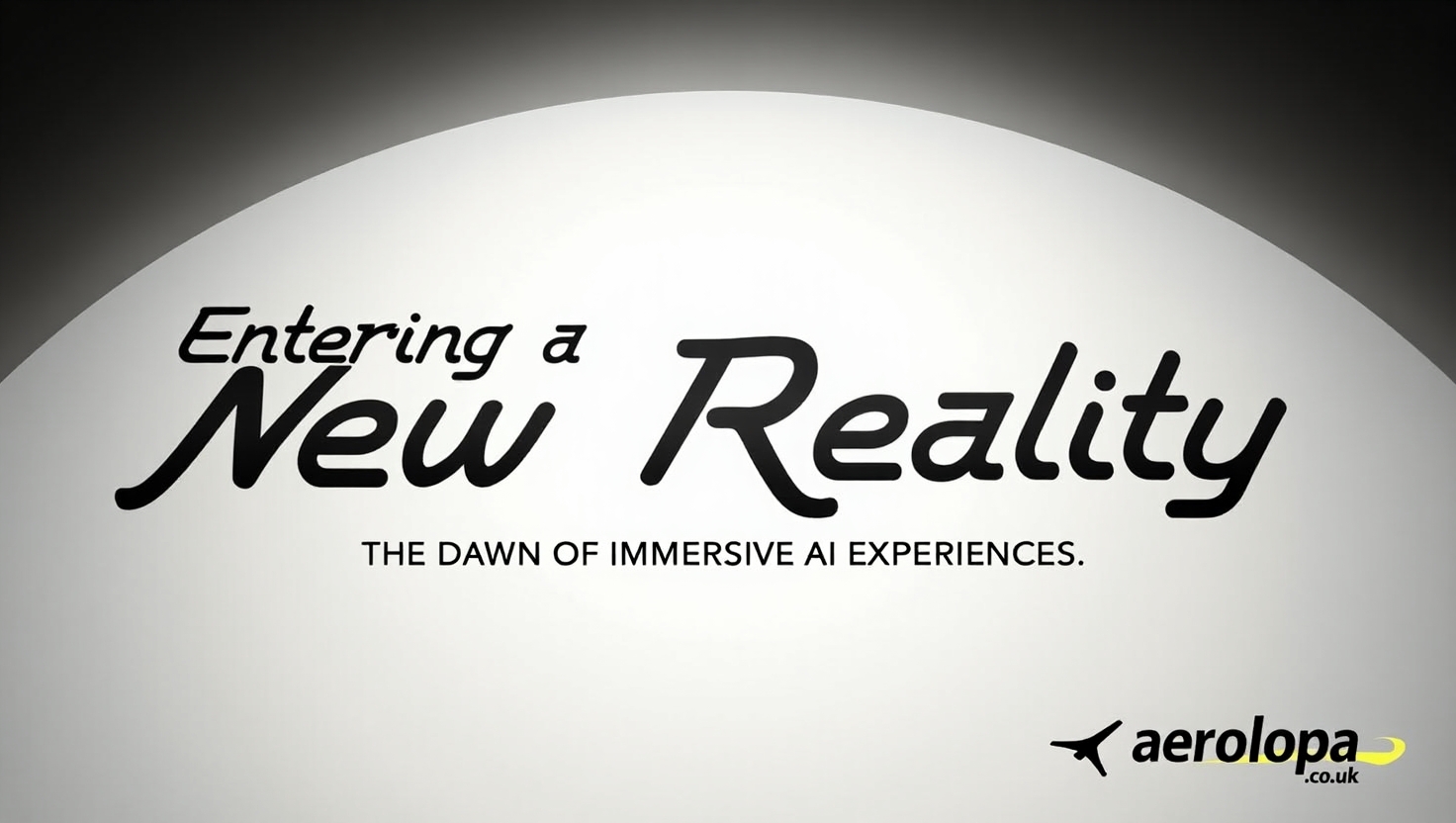The once distinct boundaries between our physical world and the digital realm are rapidly dissolving, giving rise to a groundbreaking era of “Immersive AI Experiences.” These aren’t merely captivating visuals; they are sophisticated innovations that intricately weave artificial intelligence into every fabric of virtual and augmented environments. The result? Spaces that not only engage our senses profoundly but also dynamically adapt to our presence, offering deeply personalized and astonishingly lifelike interactions. From the vibrant arenas of entertainment and the quiet halls of education to the critical fields of healthcare and intricate professional training, the transformative potential of these intelligent virtual and augmented spaces is not just reshaping how we learn, work, and play – it promises a future where digital interactions feel as natural and real as our waking lives.
What Exactly Are Immersive AI Experiences?

At its core, an immersive AI experience is a technological symphony that blends the potent force of advanced artificial intelligence with the delicate artistry of extended reality (XR) technology. Think of it as a seamless fusion of virtual reality (VR) that transports you entirely, augmented reality (AR) that overlays digital elements onto your real view, and mixed reality (MR) that blends the two seamlessly. Unlike traditional digital interactions where users are passive spectators observing a screen, immersive AI catapults them into the role of active participants, fully embedded within the experience. This profound transformation is achieved by crafting simulated environments so palpably real, they effortlessly engage multiple senses – sight and sound are paramount, often complemented by tactile sensations through haptic feedback that makes you feel textures, impacts, and resistance.
The “AI” component, however, is the true maestro orchestrating this revolution. It breathes intelligence into these environments, empowering them to:
- Adapt and Customize: Artificial intelligence algorithms are the unseen watchdogs, continuously examining user behavior, nuances of preferences, and even complex emotional states in real time. This rich stream of data then dynamically sculpts the experience, precisely tailoring content, adjusting difficulty curves, and finessing interactions to resonate uniquely with each individual participant. Imagine living in a world that changes all around you.
- Generate Dynamic Content: The days of static, pre-programmed digital worlds are fading. AI has the amazing capacity to create complex people, expansive, completely original settings, and dynamic storylines procedurally on the spot. This ensures that every single foray into these digital realms feels fresh, unpredictable, and organically responsive to your actions.
- Enable Natural Interaction: Through an exquisite blend of sophisticated natural language processing (NLP) that understands your voice, and keen computer vision that interprets your movements, users can converse with these environments and their virtual inhabitants using intuitive voice commands, fluid hand gestures, and even the subtle direction of their gaze. Interactions become effortless, almost instinctual, mimicking real-world communication.
- Simulate Realistic Behavior: AI-powered non-playable characters (NPCs) in a thrilling game or virtual assistants in a critical training scenario no longer feel robotic or predictable. Instead, they exhibit intelligent, remarkably human-like behaviors, complete with nuanced reactions and believable decision-making, making every interaction more compelling and deeply authentic.
This powerful fusion culminates in experiences that are not only visually breathtaking but also profoundly intelligent, extraordinarily responsive, and singularly personal, leaving a lasting impression.
The Transformative Impact Across Industries

The impact of immersive AI is being felt everywhere, and it promises nothing less than ground-breaking developments in numerous important fields:
Revolutionizing Learning and Development
In the hallowed realm of education, immersive AI stands poised to dismantle and redefine traditional learning paradigms. Imagine the painstaking accuracy of medical students doing difficult, life-or-death procedures in a painstakingly designed, incredibly lifelike virtual operating room. They perform intricate incisions and delicate procedures, guided by an AI tutor that offers immediate, granular feedback, pinpointing every mistake and adapting the learning pace to their individual grasp. Or picture history students not merely poring over dusty texts about ancient civilizations, but rather stepping directly into meticulously recreated historical sites – feeling the grandeur of Roman forums, strolling through busy medieval marketplaces and having lively discussions with AI-powered historical characters that vividly recreate the past.
- Personalized Learning Journeys: AI acts as an omnipresent, infinitely patient mentor, tailoring educational content with surgical precision to individual student needs. This accelerates progress for those who grasp concepts with alacrity, while providing a scaffold of additional support and alternative explanations for those who need more time to solidify their understanding.
- Enhanced Engagement and Retention: Gone are the dry lectures. Interactive simulations and ingeniously gamified learning modules, powered by the adaptive intelligence of AI, transform even the most complex subjects into captivating adventures. This ignites deeper engagement, fuels curiosity, and dramatically improves the long-term retention of knowledge.
- Scalable and Accessible Education: Immersive AI possesses the profound potential to democratize access to world-class learning resources, breaking down geographical and socio-economic barriers. It enables seamless global collaboration in richly interactive virtual classrooms and delivers highly specialized, hands-on training to remote communities who might otherwise be deprived of such opportunities.
A New Frontier in Entertainment and Gaming
The entertainment industry is already sprinting at the forefront, eagerly embracing immersive technologies, and AI is amplifying this trend with explosive force. Video games are transcending mere pixels, becoming astonishingly hyper-realistic, populated by AI-driven characters that dynamically adapt to player strategies, offering cunning challenges and surprising alliances. These worlds are no longer static backdrops but procedurally generated expanses that promise virtually endless exploration and emergent narratives. Beyond the thrilling landscapes of gaming, we’re witnessing the genesis of:
- Interactive Narratives: AI allows storylines to unfurl and twist based on viewer choices, creating truly personalized cinematic and theatrical experiences where every decision shapes a unique path. Imagine a film where you dictate the protagonist’s fate, and the narrative threads seamlessly adjust.
- Dynamic Live Events: Athletic events are buzzing with excitement, while AI-enhanced virtual concerts explode with vibrant energy. AI skillfully modifies camera angles, creates captivating soundscapes, and even orchestrates the digital crowd’s reactions based on individual user preferences. This creates an electrifying sense of being truly present, right in the heart of the action, no matter where you are physically.
- Hyper-Realistic Virtual Worlds: The grand vision of the “metaverse,” currently taking shape and propelled by advanced AI, promises interconnected digital spaces so richly detailed and persistently alive that users can effortlessly socialize, collaborate on projects, and engage in leisure activities within highly authentic, enduring virtual environments.
Advancing Healthcare and Wellness
The healthcare sector stands to reap immense benefits from the pioneering advancements of immersive AI experiences, particularly in the critical areas of rigorous training, transformative therapy, and empathetic patient engagement.
- Precision Surgical Training: Aspiring and seasoned surgeons alike can meticulously hone their intricate skills on “digital twins” of patients, painstakingly simulating complex procedures with unparalleled accuracy. They can practice delicate maneuvers, navigate anatomical complexities, and receive instant, AI-driven performance analytics that highlight every strength and area for improvement, all without risk.
- Personalized Rehabilitation: Patients embarking on physical therapy journeys can find renewed motivation through gamified exercises set within engaging virtual environments. Here, AI dynamically adjusts challenges, providing real-time feedback on form and progress, meticulously optimizing every step of their recovery journey.
- Mental Health Support: Immersive AI possesses the unique ability to create profoundly therapeutic environments, offering safe, controlled exposure therapies for debilitating phobias, managing the lingering effects of PTSD, and alleviating anxiety. Guided meditation sessions within serene virtual landscapes can also be tailored by AI, which analyzes patient responses to craft interventions for maximum effectiveness and comfort.
- Patient Education and Engagement: The often-daunting world of complex medical information can be demystified and made brilliantly accessible. Diseases, anatomical structures, and intricate treatment plans can be brought to life through interactive 3D models, allowing patients to intuitively grasp their conditions and treatment options with profound clarity and confidence.
Reshaping Professional Training and Collaboration
Beyond specific industry verticals, immersive AI is poised to fundamentally transform how professionals acquire skills and collaborate across vast distances. From the rigorous, hyper-realistic flight simulators that hone a pilot’s every instinct to the intricately detailed virtual factory floors where engineers can test designs and optimize workflows, these experiences offer unparalleled opportunities for skill development in meticulously controlled, utterly safe environments.
- Risk-Free Skill Development: Professionals can practice highly critical procedures and refine their decision-making in sophisticated simulations that mirror real-world complexities with astonishing fidelity. This allows for iterative learning, rapid correction, and mastery without the inherent risks, prohibitive costs, or logistical challenges associated with real-world training scenarios.
- Remote Collaboration and Innovation: Geographic boundaries become irrelevant as teams seamlessly convene in shared virtual workspaces. Here, they can collaboratively manipulate and annotate intricate 3D models, engage in dynamic brainstorming sessions that transcend physical whiteboards, and deliver compelling, interactive presentations that feel undeniably personal, regardless of their actual location.
- Data Visualization and Analysis: The overwhelming deluge of complex datasets can be transformed into intuitive, interactive 3D visualizations. This allows for rapid pattern recognition, deeper insights, and ultimately, more agile and informed decision-making across the vast spectrum of business functions, from financial analysis to supply chain optimization.
The Road Ahead: Challenges and Opportunities

While the monumental potential of immersive AI is undeniably captivating, its widespread, seamless adoption faces several formidable challenges. The immense computational demands required to render these incredibly detailed, dynamic worlds, coupled with the critical need for robust, low-latency infrastructure, present significant technical hurdles. Furthermore, ethical considerations surrounding the meticulous safeguarding of user data privacy and the very real potential for digital over-reliance or even addiction are areas that demand careful, proactive consideration and responsible innovation.
However, the relentless pace of technological advancement suggests that these formidable hurdles will progressively yield. Breathtaking leaps in processing power, revolutionary improvements in network connectivity (like 5G and beyond), and the continuous development of ever-more sophisticated AI algorithms will undeniably continue to fuel this astonishing evolution. As these intelligent digital realms become increasingly accessible, more intuitively designed, and seamlessly woven into the rich tapestry of our daily lives, we can confidently anticipate a future where the very boundaries of human experience are not just explored, but continually expanded and redefined.
In conclusion, immersive AI experiences are far more than a fleeting technological trend; they represent a fundamental, irreversible shift in how we interact with information, with our environments, and with each other. By forging intelligent, endlessly adaptive, and profoundly engaging digital realms, these innovations are unlocking unprecedented opportunities across learning, entertainment, healthcare, and professional development. The future isn’t merely about observing digital content from a distance; it’s about stepping directly inside it, becoming an integral part of its unfolding narrative, and actively shaping its very essence with every glance, every gesture, and every decision.

